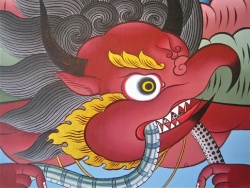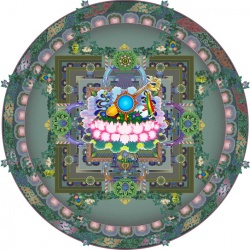Shangpa Kagyu lineage
The Shangpa Kagyu lineage originated during the eleventh century with the learned and accomplished Kyungpo Naljor. This Tibetan master reportedly traveled to India seven times and received teachings from more than 150 different masters.
Of these he considered four to be most significant, and of these four, two women, Niguma and Sukhasiddhi, provided his primary inspiration.
The vital process of unbroken transmission has ensured that the quality of their awareness animates the lineage to this day.
Exceptionally, the Shangpa Kagyu lineage remained for seven generations a one-to-one transmission, each master transmitting these instructions to a single disciple.
This "sealed" lineage's seven "jewels" were Vajra Bearer, Niguma, Kyungpo Naljor, Mokchok-pa Rinchen Tsöndru, Kyergang-pa Chökyi Sengé, Rigong-pa Sangyé Nyentön, and Sangyé Tönpa.
The lineage later included such luminaries as Thangtong Gyalpo, Taranata, and Jamgon Kongtrul Lodrö Tayé.
This lineage has managed to remain unobtrusive; most of the primary lineage holders have chosen to live as concealed yogis, to avoid institutional responsibilities, and to commit themselves to solitude and meditation.
Nevertheless, this lineage of teachings has been so valued as to spread through virtually all Tibetan traditions.
As such, many important masters of a variety of Tibetan religious traditions have played a significant role in the lineage's continuity.
Those who have met living masters of Vajrayana Buddhism will know that each one is unique, exhibiting the qualities of awakened being in his or her own manner.
In spite of Buddhism's language of detachment, renunciation, emptiness of the self and so on, the process of awakening does not imply abdication of individuality.
Rather, awakening implies the discovery of freedom.
This freedom is yet another quality of the wisdom of awakened awareness.
Full enlightenment, then, can be understood to imply a total creative freedom, as the profound intelligence of wisdom and the selfless altruism of compassion, both natural to this awakened mind, respond spontaneously and appropriately in any situation.
This freedom in awakening is undistracted and uninhibited. "Detachment" from distraction leads to the ease of relaxed natural awareness.
Perfectly focused in a state of utter ease and nondistraction, accomplished masters can be experienced by others as having a presence imbued with a vividness or intensity that is the natural expression of undissipated being.
Moreover, free of self-preoccupation, and hence purely altruistic, their being is totally free of inhibition, authentically grounded in and fearlessly expressing the integrity of the true nature of being.
With profound gratitude and appreciation, awakened masters past and present integrate into their personal identity every one of the lineage's extraordinary individuals who preceded them.
And they communicate awakening's qualities as the display and activity of the various deity configurations and techniques that characterize the vajra world of their tradition.
From the Foreword, by Lama Drupgyu Tenzin to Timeless Rapture, by Ngawang Zangpo.
Shangpa Kagyu teachings were given to students, both Eastern and Western, by Kalu Rinpoche, the lineage holder, until his death in 1989.
Preceding Kalu Rinpoche as the lineage holder and teacher was Lama Norbu Dondrup, who was the student of Jamgon Kongtrul Lodro Taye (1813-1899), a founder of the Rime (non-sectarian) tradition and one of its greatest masters.
Kalu Rinpoche was an activity emanation of Jamgon Kongtrul. "Kalu Rinpoche was a most accomplished Rime master" writes Lobsang Lhanlungpa. "He devoted himself fully to giving a variety of esoteric teachings which are usually propagated only by their respective orders."
Additionally, in the last years of his life he expressed again and again that all authentic religious and spiritual teachings are the activity of awakened mind.

